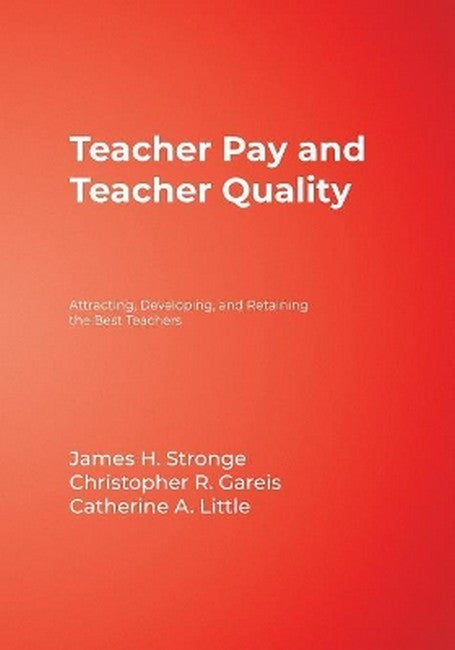James H. Stronge is the Heritage Professor in the Educational Policy, Planning, and Leadership Area at the College of William and Mary, Williamsburg, Virginia. His research interests include policy and practice related to teacher quality, and teacher and administrator evaluation. He has worked with numerous school districts and other educational organizations to design and implement evaluation systems for teachers, administrators, and support personnel. His work on effective teachers focuses on how to identify effective teachers and how to enhance teacher effectiveness. Dr. Stronge has presented his research at conferences such as American Educational Research Association and Association for Supervision and Curriculum Development, conducted workshops for national and state organizations, and worked with local school districts. He has been a teacher, counselor, and district-level administrator. His doctorate is in the area of educational administration and planning from the University of Alabama. Christopher R. Gareis, EdD, is Assistant Professor of Educational Leadership at the College of William and Mary in Virginia. He is a former high school and middle school English teacher, as well as a middle school assistant principal and principal. He also directed the teacher preparation program at William and Mary as Associate Dean, and he continues the work of developing a network of partnership schools and clinical faculty in support of preservice teacher preparation and novice teachers. He has worked with school districts, state departments of education, and schools in the areas of teacher compensation, personnel evaluation, strategic planning, facilities planning, teacher preparation, mentoring, and curriculum development. In addition to these areas, his research interests include teacher leadership and principal efficacy. , is Assistant Professor of Educational Leadership at the College of William and Mary in Virginia. He is a former high school and middle school English teacher, as well as a middle school assistant principal and principal. He also directed the teacher preparation program at William and Mary as Associate Dean, and he continues the work of developing a network of partnership schools and clinical faculty in support of preservice teacher preparation and novice teachers. He has worked with school districts, state departments of education, and schools in the areas of teacher compensation, personnel evaluation, strategic planning, facilities planning, teacher preparation, mentoring, and curriculum development. In addition to these areas, his research interests include teacher leadership and principal efficacy.
Request Academic Copy
Please copy the ISBN for submitting review copy form
Description
Acknowledgments Preface About the Authors 1. Attracting, Developing, Retaining - and Paying - Quality Teachers Examining Motivation: Do Financial Incentives Work in Promoting Teacher Quality? How We Pay Teachers: A Brief History of Teacher Compensation Current Issues and Trends in Teacher Compensation Teacher Pay and Teacher Quality Concluding Thoughts: Where Do We Go From Here? 2. Teacher Pay and School Purposes: How Do They Relate? Aligning Teacher Compensation With Organizational Purpose and Direction Moving Forward: Key Considerations for Developing a Compensation System Establishing Criteria: Defining and Measuring Quality Summary: Teacher Compensation in the Big Picture of School Purpose 3. Competitive Salaries and Benefits: How Do We Stack Up? How Do Principles of Environmental Scanning Apply to Teacher Compensation Systems? How Can the Competitiveness of Teacher Salaries Be Assessed? How Can Nonsalary Benefits Contribute to a Competitive Salary Package? What Role Can Working Conditions Play in a Competing Market? Summary: Teacher Quality and Competitive Pay 4. Considering Options for Teacher Pay: What Are the Promising Possibilities? Single-Salary Schedule Extra Duty/Additional Responsibility Pay Career Ladder Knowledge- and Skills-Based Pay Individual Evaluation Pay Performance-Based Pay Creative Compensation: Other Ways of Recognizing Teacher Quality Summary 5. Building a Model Teacher Compensation System: What Will Work Best for Us? Assumptions About Compensation Systems Design Principles: Considerations in Teacher Compensation Designing a Compensation System Aimed at Quality A Component-Parts Approach to Teacher Compensation A Model for Teacher Compensation A Closer Look at the Components of Compensation Compensation and Quality Alternatives to Consider Concluding Thoughts: Designing a Compensation System 6. From Planning to Implementation: How Do We Make This Change? Step 1: Develop the Aims and Criteria of the Compensation System Step 2: Select Compensation Components Step 3: Plan for Implementation Step 4: Pilot the Restructured Compensation System Step 5: Districtwide Implementation and Evaluation Concluding Thoughts: Teacher Quality and Teacher Pay Endnotes References Index
"The authors have amassed a tremendous amount of information and assembled it into a very readable book that will be an excellent resource." -- Randel Beaver "This is a good and needed book. I would buy it, and recommend it to a wide range of educators." -- Kenneth D. Peterson "Makes several noteworthy contributions to current deliberations about how teacher compensation systems might promote the recruitment, retention, and ongoing development of a high-quality teacher workforce." -- Teachers College Record, August 2006

